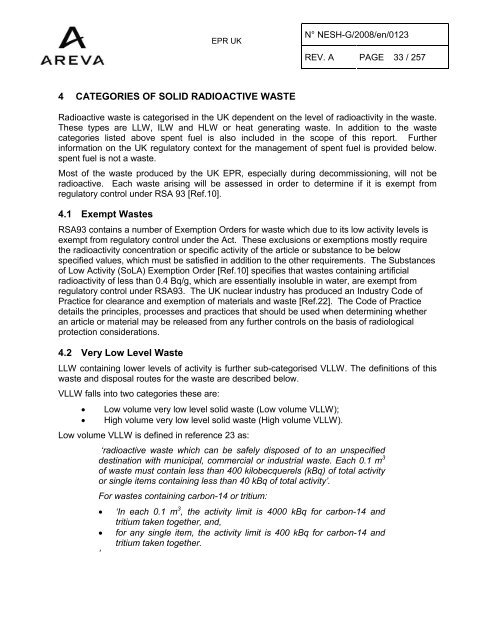Solid Radioactive Waste Strategy Report.pdf - UK EPR
Solid Radioactive Waste Strategy Report.pdf - UK EPR
Solid Radioactive Waste Strategy Report.pdf - UK EPR
You also want an ePaper? Increase the reach of your titles
YUMPU automatically turns print PDFs into web optimized ePapers that Google loves.
<strong>EPR</strong> <strong>UK</strong><br />
N° NESH-G/2008/en/0123<br />
REV. A PAGE 33 / 257<br />
4 CATEGORIES OF SOLID RADIOACTIVE WASTE<br />
<strong>Radioactive</strong> waste is categorised in the <strong>UK</strong> dependent on the level of radioactivity in the waste.<br />
These types are LLW, ILW and HLW or heat generating waste. In addition to the waste<br />
categories listed above spent fuel is also included in the scope of this report. Further<br />
information on the <strong>UK</strong> regulatory context for the management of spent fuel is provided below.<br />
spent fuel is not a waste.<br />
Most of the waste produced by the <strong>UK</strong> <strong>EPR</strong>, especially during decommissioning, will not be<br />
radioactive. Each waste arising will be assessed in order to determine if it is exempt from<br />
regulatory control under RSA 93 [Ref.10].<br />
4.1 Exempt <strong>Waste</strong>s<br />
RSA93 contains a number of Exemption Orders for waste which due to its low activity levels is<br />
exempt from regulatory control under the Act. These exclusions or exemptions mostly require<br />
the radioactivity concentration or specific activity of the article or substance to be below<br />
specified values, which must be satisfied in addition to the other requirements. The Substances<br />
of Low Activity (SoLA) Exemption Order [Ref.10] specifies that wastes containing artificial<br />
radioactivity of less than 0.4 Bq/g, which are essentially insoluble in water, are exempt from<br />
regulatory control under RSA93. The <strong>UK</strong> nuclear industry has produced an Industry Code of<br />
Practice for clearance and exemption of materials and waste [Ref.22]. The Code of Practice<br />
details the principles, processes and practices that should be used when determining whether<br />
an article or material may be released from any further controls on the basis of radiological<br />
protection considerations.<br />
4.2 Very Low Level <strong>Waste</strong><br />
LLW containing lower levels of activity is further sub-categorised VLLW. The definitions of this<br />
waste and disposal routes for the waste are described below.<br />
VLLW falls into two categories these are:<br />
· Low volume very low level solid waste (Low volume VLLW);<br />
· High volume very low level solid waste (High volume VLLW).<br />
Low volume VLLW is defined in reference 23 as:<br />
‘radioactive waste which can be safely disposed of to an unspecified<br />
destination with municipal, commercial or industrial waste. Each 0.1 m 3<br />
of waste must contain less than 400 kilobecquerels (kBq) of total activity<br />
or single items containing less than 40 kBq of total activity’.<br />
For wastes containing carbon-14 or tritium:<br />
· ‘In each 0.1 m 3 , the activity limit is 4000 kBq for carbon-14 and<br />
tritium taken together, and,<br />
· for any single item, the activity limit is 400 kBq for carbon-14 and<br />
tritium taken together.<br />
’

















